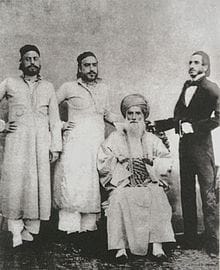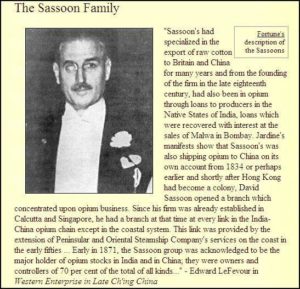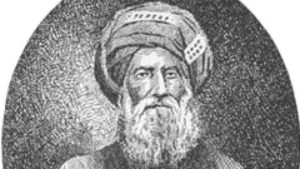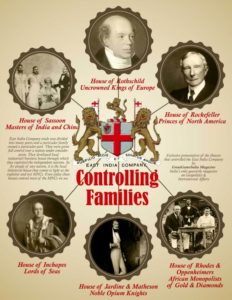The Sassoon family profited from the opium trade in the 19th Century more than any drug dealer in history. They made Pablo Escobar look like a pisher.
The Ben Ish Chai (R. Yosef Hayyim) was the Sassoon family’s representative in Baghdad.
According to the 1906 Jewish Encyclopedia entry on David Sassoon: “his business, which included a monopoly of the opium-trade, extended as far as Yokohama, Nagasaki, and other cities in Japan. Sassoon attributed his great success to the employment of his sons as his agents and to his strict observance of the law of tithe.”
Fortune magazine 1930s
When the Treaty of Nanking opened up China to British traders, Sassoon developed his textile operations into a profitable triangular trade: Indian yarn and opium were carried to China, where he bought goods which were sold in Britain, from where he obtained Lancashire cotton products. He sent his son Elias David Sassoon to Canton, where he was the first Jewish trader (with 24 Parsi rivals). In 1845 David Sassoon & Sons opened an office in what would soon become Shanghai’s British concession, and it became the firm’s second hub of operations.
In 1844, he set up a branch in Hong Kong, and a year later, he set up his Shanghai branch on the Bund to cash in on the opium trade.
“In Jewish history books, David Sassoon, an observant Jew, is remembered mostly for his philanthropy.”
On November 7, 1864, businessman David Sassoon, founding father of the Sassoon business dynasty, died in Pune, India. The trading empire he created spanned the globe, from what is now Mumbai on the western coast of India, via Shanghai and Hong Kong in China, all the way to London, England. It dominated world commerce in a number of commodities – most significantly opium – over the second half of the 19th century.
Sassoon was born in Baghdad in 1832 to Saleh Sassoon, a businessman and leader of that city’s Jewish community (the clan claimed descent from a Spanish family, the Ibn Shoshans). When David Sassoon, who like his father served as treasurer to the governors of Baghdad, clashed with one of them, Daud Pasha, he moved his family to Persia in 1826, and then to Bombay by 1832.
Sassoon initially owned a counting house and a carpet warehouse, but soon began trading in everything he could, including, most profitably, opium. When China’s emperor tried to outlaw the drug, which cut a wide swathe of destruction through the population of the country’s coastal regions, the British responded with war. The result was the 1842 Treaty of Nanking, which earned the United Kingdom a free hand in selling opium in China.
Sassoon established a triangle of trade, bringing Indian opium and cotton to China, where he received silver, tea and silk in exchange. He then carried these products to England for sale. Finished products from Britain, as well as cash, were then brought back to India where they were used to buy more opium. By the 1870s, David Sassoon had come to dominate the trade of opium to China, having pushed the British firm Jardine Matheson and the “Parsi” traders of Bombay out of the business.Sassoon’s eights sons all went into one branch or another of the family’s business empire, with the Sassoon presence being felt in Hong Kong, Shanghai (where they became major players in the realm of real estate), and India (where they had their own textile mills), among many other lands. The vast Sassoon Docks of Bombay, built by Sassoon’s son Albert Abdullah, were the first wet docks in the west of India.
In Jewish history books, David Sassoon, an observant Jew, is remembered mostly for his philanthropy, which included the construction of “Baghdadi” synagogues in Bombay (Magen David) and Pune (Ohel David), and also numerous schools and hospitals throughout India and other parts of Asia. David became a naturalized British citizen in 1853, although he continued to live in Pune.
His son Albert Abdullah moved to England, where he married into the Rothschild family and was elected to Parliament on the Conservative party’s ticket. Another son, Sassoon David Sassoon, was the father of Rachel Sassoon Beer, who became owner and editor of the Sunday Times at the turn of the century, and grandfather of the great poet of World War I, Siegfried Sassoon.
According to the 1944 Jewish Encyclopedia: “He employed only Jews in his business, and wherever he sent them, he built synagogues and schools for them. He imported whole families of fellow Jews…and put them to work.”
According to the 2003 book, Jews, Opium and the Kimono:
As British rule consolidated in India, there arose a greater need for employees to oversee their affairs. This need was a godsend for Bombay’s Babylonian Jews, who saw enormous financial potential in the opium trade. Transactions were discussed after prayers at the synagogues…
…it was his [David Sassoon’s] agents who set the prcies for the various types of opium products…
The location of Shanghai, along the Whangpoo River, together with David Sassoon’s Jewish genius and foresight — were what made possible the passage of steamships into the Chinese hinterland, carrying valuable cargoes of opium…Wealthy Jews, such as Silas Hardoon, who had made his money in the opium trade and subsequently moved into real estate and respectability, built fabulous mansions in the most prestigious parts of the city [Shanghai]…
Opium, that staple drug of the Chinese people, infuriated the Chinese intelligentsia, who waged a stubborn battle against its use… [The Society to Combat the Opium Trade’s]…demands faced the open hostility of British government officials in India who regarded the destruction of the opium fields as a hard blow to teh country’s economy. These officials were joined by the opium traders of Calcutta and Bombay, most of them Jewish, who controlled two-thirds of the trade on the Calcutta exchange…
The Jews hated the rickshaw, which they considered immoral — forcing a man to do the work of a beast. (Pg. 44-46)
EIC [East India Company] trade as mentioned earlier was divided into many parts and a particular family owned a particular part. For example, the growing of opium and collecting taxes in India was owned by EIC and its paid officials or after 1837 by the British government itself. But the House of Sassoon’s handled the trading in opium and other goods in India. Thereafter, the House of Jardine and Matheson handled their distribution in China and the House of Inchapes handled the shipping of these goods. House of Openheimers/Rhodes handled the gold and diamond mining business. The American operations were handled by the House of Rockefellers, Seagrams, Sassoons, Japhets, Jardine – Mathesons etc. The Houses of Rothschilds and Warburgs coordinated the banking aspect of this trade. Apart from theses, Houses of Lloyds, Abes and Astors assisted these operations by insuring the business of EICs. Even today these houses control most of the MNCS we see. We do an in-depth study of Rothschilds and Rockefellers and at the end give a list of Indian MNCs, only to show how most of these belong to only one single group run by a single family which was associated with the EIC owners, by either business or marriage.
East India Companies had a unique managerial style. In any particular country, all trading, business and commerce was always handed over to one or at the most two business houses. They were given full control over a nation under consideration. From 1800 to 1947, the House of Sassoon controlled most of the trade within India: banking, trading, shipping, insurance etc., from their Mumbai headquarters. Most of them started moving out of India and to England from 1900. Wherever the MNCs were in operation, they followed the above rule. They developed local industrial/business house (India is a large nation so we may encounter multiplicity in case of India), through which they exploited the independent nations.




